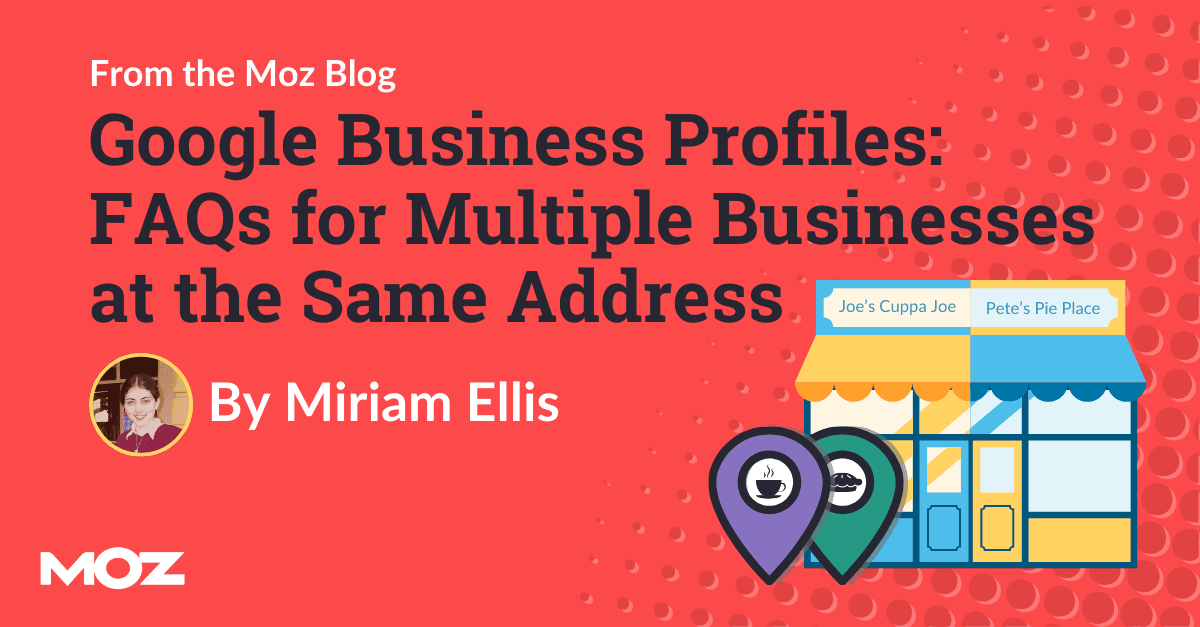
Google Business Profile: FAQ for Multiple Businesses at the Same Address
The author’s views are entirely their own (excluding the unlikely event of hypnosis) and may not always reflect the views of Moz.
How should I use Google Business Profiles (GBPs) if I’ve got multiple businesses at the same address? How many listings am I eligible for if I’m legitimately running more than one business at my location? What determines eligibility, and what penalties might I incur if I make a mistake? How should I name my businesses at the same address?
The FAQs surrounding this single, big topic fill local SEO forums across the web, year after year.
The guidelines for representing your business on Google contain most of the answers you’re seeking about co-located businesses, but sometimes they can err on the side of too little detail, leading to confusion.
Today, Iet’s quickly tackle the commonest FAQs that local business owners and marketers raise related to this scenario.
Q: I have more than one business at the same address. Can I have more than one Google Business Profile?
A: If you are legitimately operating multiple, legally distinct businesses, you can typically create a Google Business Profile for each of them. It’s not at all uncommon for more than one business to be located at a shared address. However, keep reading for further details and provisos.
Q: How do I know if my multiple businesses at the same address are distinct enough to be eligible for separate Google Business Profiles?
A: If each brick-and-mortar business you operate is separately registered with appropriate state and federal agencies, has a unique Tax ID with which you file separate taxes, meets face-to-face with customers, and has a unique phone number, then it’s typically eligible for a distinct GBP. However, keep reading for more information.
Q: Can service area businesses list multiple businesses at the same address?
A: Google has historically treated SABs differently than brick-and-mortar businesses, and this is one of the greyest areas of information in the Google Business Profile arena.
It’s not at all uncommon for the same person to own two service area businesses at the same address. For example, you might be a part-time plumber and also a part-time fence builder who goes to your clients’ locations to perform your work. There is no official statement in Google’s guidelines forbidding co-located service area businesses like these from each having a listing, but many local SEOs will discourage clients from attempting to create them. This is because Google has a history of not approving such listings, as though there is an unwritten rule against them.
The truth is, you may be able to find live listings for co-located SABs that have somehow made it into the system. If you decide to experiment with creating such listings, you should go into the attempt with the knowledge that Google may either refuse them at the outset or suspend one or both listings later. Know the risks and determine whether the experiment is worth it to you or if you need to come up with a different methodology for promoting your two different operations, such as getting a different location for one of them.
Q: What would make me ineligible for more than one Google Business Profile at the same address?
A: If your businesses aren’t registered as legally distinct entities or if you lack unique phone numbers for them, you are ineligible to list them separately. Also, if your businesses are simply representative of different product lines or services you offer under the umbrella of a single business — like a handyman who repairs both water heaters and air conditioners — they aren’t eligible for separate listings. Additionally, do not list multiple businesses at PO boxes, virtual offices, mailboxes at remote locations, or at locations you don’t have the authority to represent.
Q: Will I be penalized if I list multiple ineligible businesses at the same address?
A: Yes, you could be. Google could issue a hard suspension on one or more of your ineligible listings at any time. A hard suspension means that Google has removed your listing and its associated reviews. If Google suspects your account of engaging in serious spamming, you might also receive an account-level suspension. For an excellent rundown on the many types of suspensions that can occur due to guideline violations, I recommend reading this article from Sterling Sky: The Ultimate Playbook for Google Business Profile Suspensions.
Q: Will suite numbers help me convince Google I actually have two locations so that I can have more than one GBP?
A: No. Google doesn’t pay attention to suite numbers, whether legitimate or created fictitiously. Don’t waste time attempting to make a single location appear like multiple locations by assigning different suite numbers to the entities in hopes of qualifying for multiple listings.
Q: Can I list my business at a co-working space, even though there are multiple businesses at the same address?
A: In order for you to create a listing for your business at a co-working space, it must meet the following criteria:
-
Have street-level signage for your business
-
Be staffed by your company during your stated hours of operation
-
Have a unique phone number that is staffed during hours of operation; a phone that is answered by the general office of the co-working space is not acceptable
-
Serves customers face-to-face at the location during hours of operation
It’s important to know that if any of the other businesses at the location share your categories or are competing for the same search terms, it is likely that you or your competitors will be filtered out of Google’s mapping product due to the shared elements.
Q: How many GBPs can I have if there are multiple seasonal businesses at my address?
A: If your property hosts an organic fruit stand in summer and a Christmas tree farm in the winter, you need to closely follow Google’s requirements for seasonal businesses. In order for each entity to qualify for a listing, it must have year-round signage and set and then remove its GBP hours at the opening and closing of its season. Each entity should have a distinct name, phone number and Google categories.
Q: How should I name my multiple businesses at the same address?
A: To decrease the risk of filtering or penalties, co-located businesses must pay meticulous attention to allowed naming conventions. Questions surrounding this typically fall into five categories:
-
If one business is contained inside another, as in the case of a McDonald’s inside a Walmart, the Google Business Profile names should be “McDonald’s” and “Walmart,” not “McDonald’s in Walmart.”
-
If co-located brands like a Taco Bell and a Dunkin’ Donuts share the same location, they should not combine their brand names for the listing. They should either create a single listing with just one of the brand names or, if the brands operate independently, a unique listing for each separate brand.
-
If multiple listings actually reflect eligible departments within a business — like the sales and parts departments of a Chevrolet dealership — then it’s correct to name the listings Chevrolet Sales Department and Chevrolet Parts Department. No penalties should result from the shared branding elements so long as the different departments have some distinct words in their names, distinct phone numbers, and distinct GBP categories.
-
If a brand sells another brand’s products — like Big-O selling Firestone Tires — don’t include the branding of the product being sold in the GBP business name. However, Google stipulates that if the business location is an authorized and fully dedicated seller of the branded product or service (sometimes known as a “franchisee”), you may use the underlying brand name when creating the listing, such as “TCC Verizon Wireless Premium Retailer.”
-
If an owner is starting out with several new businesses at the same location, it would be a best practice to keep their names distinct. For example, a person operating a pottery studio and a pet grooming station out of the same building can lessen the chance of filters, penalties, and other problems by avoiding naming conventions like “Rainbow Pottery” and “Rainbow Pet Grooming” at the same location.
Q: Can I create separate listings for classes, meetings, or events that share a location?
A: Unfortunately, the guidelines on this topic lack definition. Google says not to create such listings for any location you don’t own or have the authority to represent. But even if you do own the building, the guidelines can lead to confusion. For example, a college can create separate listings for different departments on campus, but should not create a listing for every class being offered, even if the owners of the college do have authority to represent it.
Another example would be a yoga instructor who teaches at three different locations. If the building owners give them permission to list themselves at the locations, along with other instructors, the guidelines appear to permit creating multiple listings of this kind. However, such activity could end up being perceived as spam, could be filtered out because of shared elements with other yoga classes at a location, and could end up competing with the building’s own listing.
Because the guidelines are not terribly clear, there is some leeway in this regard. Use your discretion in creating such listings and view them as experimental in case Google should remove them at some point.
Q: How do I set GBP hours for co-located business features that serve different functions?
A: A limited number of business models have to worry about this issue of having two sets of hours for specific features of a business that exist on the same premises but serve unique purposes. For example, a gas station can have a convenience market that is open 6 am to 10 pm but pumps that operate 24 hours a day. Google sums up the shortlist for such scenarios this way, which I’ll quote verbatim:
-
Banks: Use lobby hours if possible. Otherwise, use drive-through hours. An ATM attached to a bank can use its own separate Business Profile with its own different hours.
-
Car dealerships: Use car sales hours. If hours for new car sales and pre-owned car sales differ, use the new sales hours.
-
Gas stations: Use the hours for your gas pumps.
-
Restaurants: Use the hours when diners can sit down and dine in your restaurant. Otherwise, use takeout hours. If neither of those is possible, use drive-through hours or, as a last resort, delivery hours.
-
Storage facilities: Use office hours. Otherwise, use front gate hours.
- To highlight times for specific services, you can also set More hours.
- In general, you should set More hours as a subset of your primary hours.
Q: How can I list my co-located ghost kitchen or virtual food brand?
A: The rise of the phenomenon of entities known as “ghost kitchens,” “cloud kitchens,” “dark kitchens,” and other names has inspired Google to add a special section to the guidelines just for these models. You should read it in full if this is the type of business you’re marketing, but in short, you are typically allowed to create GBPs for them if you follow these rules:
-
You must have street signage at your virtual kitchen.
-
You can show your address on the listing only if you offer food pickup to all customers.
-
If you only deliver food to customers, you must have a distinct website and branding/packaging of your food to qualify for a listing. You should hide your listing’s address. You can set up a service area. You should expect Google to make you take extra steps to verify listings in this scenario.
Q: Could the details of my Google listing get mixed up with another business at my location?
A: Not long ago, local SEO blogs frequently documented cases of listing “conflation”. Details like similar or shared names, addresses, or phone numbers could cause Google to merge two listings together, resulting in strange outcomes like the reviews for one company appearing on the listing of another. This buggy mayhem, thankfully, has died down to the extent that I haven’t seen a report of listing conflation in some years. However, it’s good to remember that errors like these made it clear that each business you operate should always have its own phone number, naming should be as unique as possible, and categories should always be carefully evaluated.
Q: Why is only one of my multiple businesses at the same location ranking in Google’s local results?
A: The commonest cause of this is that Google is filtering out all but one of your businesses from ranking because of listing element similarity. If you attempt to create multiple listings for businesses that share Google categories or are competing for the same keyword phrases at the same address, Google’s filters will typically make all but one of the entities invisible at the automatic zoom level of their mapping product. For this reason, creating multiple GBPs for businesses that share categories or industries is not a best practice and should be avoided.
Q: My GBP is being filtered due to co-location. What should I do?
A: This topic has come to the fore, especially since Google’s rollout of the Possum filter on September 1, 2016. Businesses at the same address (or even in the same neighborhood) that share a category and are competing for the same search phrases often have the disappointment of discovering that their GBP appears to be missing from the map while a co-located or nearby competitor ranks highly. Google’s effort to deliver diversity causes them to filter out companies that they deem too similar when they’re in close proximity to one another.
If you find yourself currently in a scenario where you happen to be sharing a building with a competitor, and you’ve been puzzled as to why you seem invisible on Google’s maps, zoom in on the map and see if your listing suddenly appears. If it does, chances are, you’re experiencing filtering.
If this is your predicament, you have a few options for addressing it. As a measure of last resort, you could relocate your company to a part of town where you don’t have to share a location and have no nearby competitors, but this would be an extreme solution. More practically speaking, you will need to audit your competitor, comparing their metrics to yours, to discover why Google sees them as the stronger search results. From the results of your audit, you can create a strategy for surpassing your opponent so that Google decides it’s your business that deserves not to be filtered out.
Q: How can I scale management of multiple GBPs?
A; I’ve saved what’s probably the most problematic question for last. Since Google’s 2022 replacement of their historic Google My Business management dashboard with the New Merchant Experience, management of multiple listings has become notoriously difficult for multi-location business owners and marketers.
Instead of having an organized and somewhat efficient private dashboard for editing, maintaining, and optimizing your listings, all such functions are now performed amid the mess of the organic SERPs, as shown above. Multiple SEOs have called the NMX “dreadful” and “a nightmare” in the multi-location business scenario and recommend using listings management software to make sense of the situation again. Moz Local can help you manage multiple listings with a few clicks and far less hassle in a neat and tidy dedicated dashboard.
Summing up
There’s nothing wrong with multiple businesses sharing an address. Google’s local index is filled with businesses in this exact situation ranking just fine without fear of penalization. But the key to success and safety in this scenario is definitely in the details.
Assessing eligibility, accurately and honestly representing your brand, adhering to guidelines and best practices, and working hard to beat the filters will stand you in good stead.
Moz Local
Improve your online presence and reach more customers.





